Located in the East Valley of south-central Arizona, the Gilbert area began as a prime farming community fueled by the construction of the Roosevelt Dam and Eastern and Consolidated Canals in 1911. Know as the “Hay Capital of the World” until the late 1920s, the town began to take shape in the 1970s, growing to a population of 1,971.
Even into the early 2000s, dairies, horse farms, and hayfields connected subdivisions and small businesses. As the town followed in the footsteps of neighboring Tempe, Mesa, and Chandler, Gilbert has since grown to a thriving community of 270,000 people.
But amid the tidy new buildings, shopping centers, and traffic lights, pockets of backyard agriculturalists still exist, where families irrigate Bermudagrass and citrus and raise small numbers of livestock. At the Gilbert Town Plaza, the original 1927 water tower has become a historical marker for the town. Agritopia, a 166-acre mixed-use planned community, was developed as an “agrihood” — complete with housing plots, a certified organic farm, and commercial spaces.
The oldest public school in Gilbert is Gilbert High School, established in 1918. It’s where thousands of students now come to receive their education. Tucked behind the sporting fields, the Gilbert FFA program’s land lab provides opportunities for students to raise livestock, grow plants in the school greenhouse, and get their hands in the dirt.
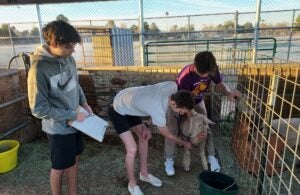
Gilbert FFA has three instructors. FFA advisor Ken Johnson has been teaching at the school for 30 years. Meanwhile, Kori Dorsey has been part of the school’s program for three years. Last year, Casey Farnsworth joined the team at Gilbert High School after teaching for 13 years in Casa Grande and Chino Valley.
“The big city is moving in all around us, but we’re still going strong,” Farnsworth said. “Our program is just over 300 members, with many school-based SAE projects that students can take advantage of — although ag mechanics and animals are the school’s two biggest projects.”
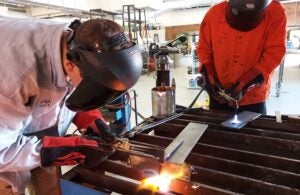
In the school’s building, a meat lab and ag mechanics shop allow hundreds of FFA members and ag students to gain hands-on experience.
Established in 1929, the school’s meat lab opened in the 1970s. As the only high school in the state with a meat lab, students from nearby Highland, Mesquite, and Campo Verde high schools can attend meat science classes before first-period classes resume at their home campus. The students gain hands-on experience harvesting and further processing livestock for area residents.
The meat lab currently processes about 50 animals per year — mainly pigs and lambs, with some steers processed after fair time. The meats lab is also licensed with Arizona Game and Fish to process game animals, which Farnsworth says he would like to incorporate into the program again as they are currently only processing domestic livestock.
“We’re pretty slammed. If we’re not harvesting, we’re cutting and wrapping,” explained Farnsworth. “The class is probably 50 percent male and female, and since I’ve been here, the interest in students wanting to take the class next year has grown.”
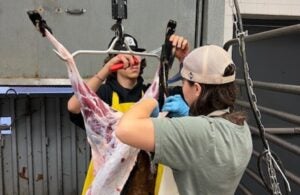
In the past year, the high school has added upgrades to the facility, such as a smoker to smoke and cure hams and bacon for customers and a commercial vacuum sealer, allowing customers to have paper-wrapped meat or vacuum-sealed meat products.
Between the land lab, where students can rent pens through a lottery system to raise livestock, and the meat lab, the Gilbert FFA’s program allows students a farm-to-plate experience.
“Whatever we can do to keep things as real as possible, so they’re trained and ready for any career pathway,” said Farnsworth. In February, the high school hosts the state’s meat judging contest, typically hosted at the University of Arizona’s meat lab.
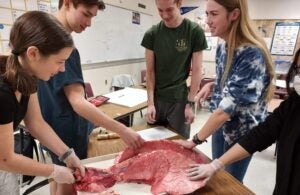
Poultry is another area that Farnsworth hopes to expand student’s meat processing experience to. Outside at the land lab, he hopes to turn the ground that used to hold the school’s tilapia pond into an area to raise turkeys for the meats class to process for Thanksgiving.
Farnsworth hopes that the FFA programs provide experiences that go beyond the classroom.
“Thirteen years ago, I was looking at getting on with the game and fish department as a game warden when my ag teacher called and said, ‘Why don’t you come and interview?’ FFA and my high school ag program changed my world. And here I am, 13 years later, still teaching,” Farnsworth said with a laugh.
It’s that connection to farming and agriculture through FFA that Farnsworth hopes to continue building in his students at Gilbert High School.
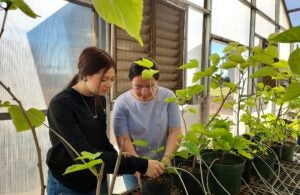
“It’s always good to see when kids graduate, move on, and be successful,” he said. “Regardless of whether it’s a career or not, I have kept in contact with many of my students over the years, and you can see how they continue using things they learned here, even if it’s just growing a garden at home, in the future.”
Heidi Crnkovic, is the Associate Editor for AGDAILY. She is a New Mexico native with deep-seated roots in the Southwest and a passion for all things agriculture.



